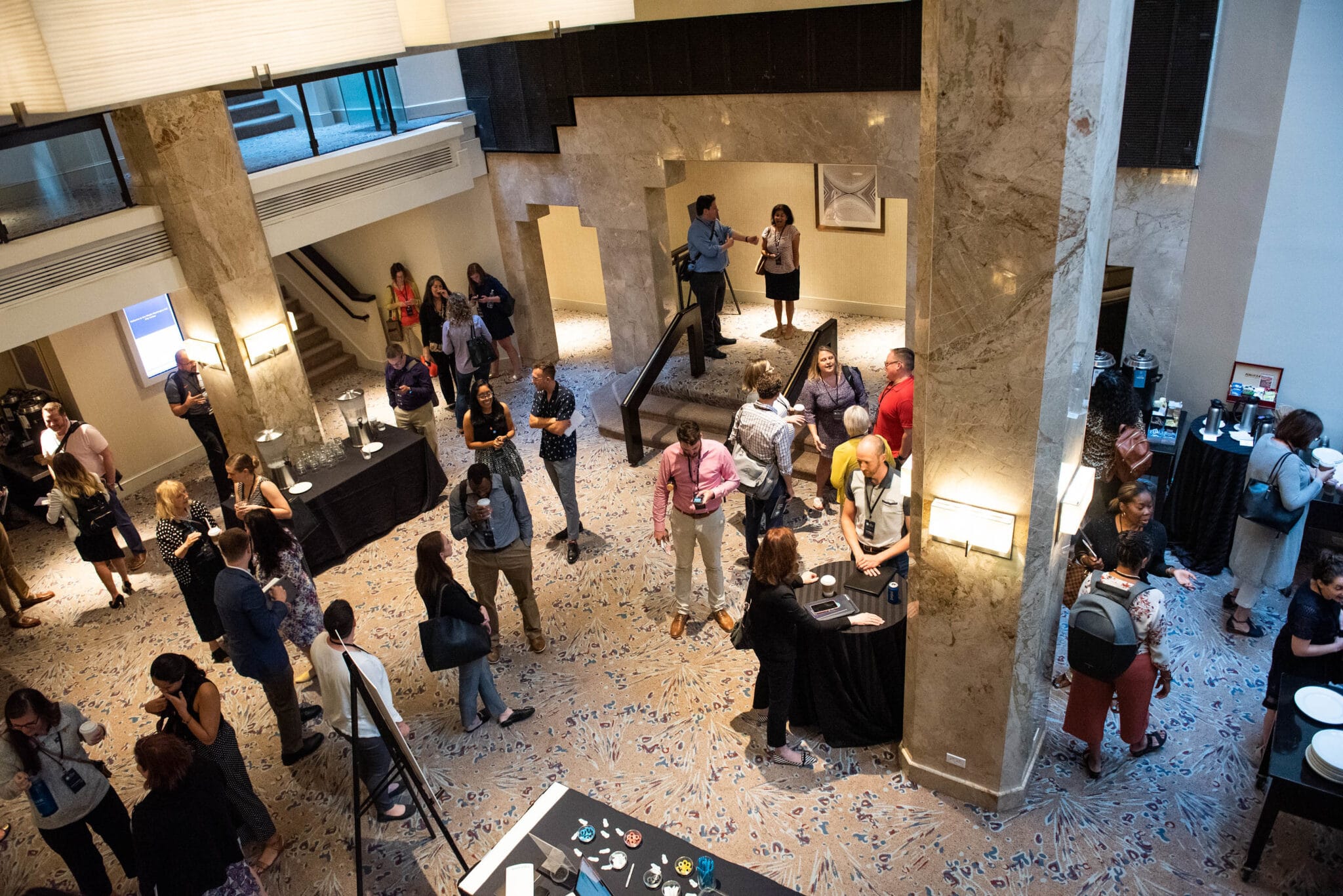This blog post continues our new series, Scholar at Large, written by an academic exploring both the traditional tenure track, and the not-so-traditional alternative academic job market.
In my first post about broader career exploration, I discussed three things I would do to get in touch with the non-academic job market. One of those items was setting up an informational interview. To wade into the waters of informational interviewing and get myself comfortable, I started with more familiar spaces: an institution of higher education and the education-focused non-profit world. What follows is an account of how I approached this interview, as well as how I think my takeaways can help me on both the traditional academic job market and the more expansive job market for PhD’s.
I thought about who and what I wanted to talk about.
This past summer, I worked for the Center for Talented Youth (CTY), a Johns Hopkins-affiliated non-profit focused on gifted education. While there, I met Sean Watkins, who earned his PhD in Media and Communication, with a focus in cultural studies, in 2013. Sean took on a job as an assistant program manager shortly after he defended his dissertation, and has moved into the role of program manager during the past five years. Sean shapes and manages some of CTY’s many summer programs. His job involves a range of tasks, including:
- Curriculum development and teacher training
- Facilitating Hopkins research studies
- Turning new research on child development into summer programming
- Gathering information from and responding to student and family concerns
- And managing full-time and summer staff
Some of this work sounded very familiar to the realm of traditional academia; some of it seemed farther afield. I was interested in hearing more about the extent to which his preparation as an academic translated to this work, and how he managed the transition. Unsurprisingly (given our training as scholars), we ended up talking far more broadly about trends he’s observed in how academia graduate programs prepare graduate students as young professionals.
“You can’t continue to have that number of folks in your programs and not train them how to get the jobs that they will end up getting. It’s a disservice to not only their experience but also to the world, because us PhDs actually have really great things to contribute outside of academia.”
I spent time preparing for the interview and what I wanted to learn.
I used my baseline familiarity with Sean’s work to develop some questions that would help me understand his trajectory, and how that translates to the work he’s doing now. I developed questions related to:
- His educational path and work experience prior to CTY
- His job search process and experience
- His transition to working at CTY
- How the work he trained for translated to the work he does now
- What graduate students, and graduate programs, can do to better account for non-academic or non-traditional academic careers
I had four major takeaways after talking with Sean.
These are a just a few of the insights I gained during the course of our conversation. I’ve included an edited version of Sean’s comments with each point.
1. The work you do in graduate school—and more importantly, the work you love to do—can translate to the impact you can make in the world more broadly.
Much of Sean’s work draws from the same interests that drew him to and through graduate school. He emphasizes the difference as a matter of impact. His interests have complimented the needs of CTY: “One of the things I valued in my graduate programs was being in an environment of folks wanting to learn, to push themselves, to do the research and have discussions about it. I’ve recreated some of those experiences here at CTY.” Related to his work on diversity, Sean has run film series, reading and discussion groups. “Today,” he says, “I’m looking at research on summer camps and supporting LGBTQ students. But I’m doing so while knowing that I’ll be implementing that research for thousands of students. So I’m using my Critical Marxist framework for thinking about the world; but I’m not just thinking with that framework, I’m doing something with that framework.”
Beyond implementing his research interests and methodologies, Sean has been able to draw from his experience with teaching as a graduate assistant. “I happen to be working at an ed nonprofit,” he says, commenting on how that work prepared him. “I’m the chair of the humanities and writing committee, we develop curriculum, I’ve developed a bunch of new classes over the time that I’ve been here. Being the lead instructor in a classroom has really helped me here think about the needs of our instructors and students.”
2. But… academia can teach you some bad habits for being a professional.
Sean explains, “I was a person who went straight through grad school. There’s a benefit to that – I was 28 when I got my PhD. One of the things I wish I’d had more experience doing was having real jobs. I got too many bad habits in academia.”
The truth is, he says:
“I had these expectations of myself and others that came down to feeling full of myself because I’m a PhD. When I first began my work here, I felt like I was in a position where I could be the leader when I really wasn’t. I didn’t know anything.
You get a lot of good things from your PhD program – you learn to articulate complex thoughts, to argue for what you believe in. But this doesn’t translate to using Excel in a job, and doesn’t translate necessarily for how to manage people. When you’re an academic, you can basically do your own thing. I developed bad habits for how I communicated with my students that are standard for academia, but that don’t translate to how you communicate with colleagues. I can’t be like the busy professor sending one-word answers over email; I have to set a conscious model for how professionals communicate with each other.”
Sean also remarks on how his work now has led him to reflect on what his graduate training missed, as well as helped him continue to grow the skills he began honing in graduate school in new ways. “It’s been a mutual relationship,” he explains. “I wish I could go back and redo some of the teaching I did as a graduate student. My pedagogy would be more differentiated, less elitist, and more understanding of students and the competing priorities they juggle. Now part of what I do is teach people how to teach, and I help them think through how to modify what they do for our population. The things I now train teachers to do, I wasn’t good at because no one taught me how to teach.”
3. There are a few things graduate students can do to more holistically prepare themselves for the professional world.
Sean encourages folks with PhDs or training for PhDs to let go of their elitism about how and where they apply their skills and knowledge. “We can use our knowledge to do different things and that’s okay, it’s not the end of the world.”
He mentioned a few pragmatic ways grad students and recent PhDs can make themselves legible within the professional world (and enhance the impact of their work at the same time):
- Capitalize on your summer work. “Take summer gigs seriously. Use them to develop yourself as a professional in a way that your PhD program is incapable of doing.”
- Build a broad network of people. “If you want to get a job that pays well in an area that you want to live, you have to know somebody who can help get your resume in the right hands.”
- Branch out and dabble in things, or connect your research to something that could be translated into a job. He gives an example from his own field of cultural studies: “I’m going to focus on health communication, and use a survey of a hospital as part of my research. You can then say, ‘I spent all of this time working with administrators and health professionals – I know how to talk to them.’”
4. Grad programs can do a better job of helping students with this.
Sean observes that many of the people in the primary position of mentoring undergraduates into grad school went to grad school themselves or experienced the job market back in the 90s. Folks who are charged with admitting and training graduate students (and now, preparing them for other potential options in the glut of the job market) haven’t been outside of academia in decades. This makes the crucial shift in mentality about academic careers very difficult.
“There should be value given to whatever path someone’s career takes them in,” he urges. “As grad students are told to be data-driven; programs also need to be transparent with the realities of what comes next.” Sean suggested bringing career services into departments: “It would have been nice to have a class on professional training, or even on exploring jobs outside of the typical academic track.”
After this conversation, I’m convinced that informational interviews are great, low-stakes opportunities for growth.
Aside from a rich and thoughtful conversation with a colleague, I gained two tangible things from my interview with Sean that I can leverage on the academic and non-academic job market:
- Insight about what kinds of soft and technical skills I may have developed through my research that I can be more aware of.
- An ability to speak very specifically about how the work of the humanities enters the world – something that goes beyond the “critical thinking” pitch we so often throw at undergraduates to take our classes. I can bring my knowledge of this to any department invested in recruiting students as well as equipping their majors or graduate students to enter the the broader career world.
I’m optimistic that continuing to do a variety of informational interviews will only add to these outcomes. These interviews will prove to be rich and thought-provoking conversations about how to be a holistic practitioner of the humanities, whether within or without the academy.
Have you taken steps to explore the alt-ac market while on the academic job market? Share your insights with me on Twitter (@mollyappel).
Interfolio’s Dossier enables scholars to collect, curate, polish and send out their materials at all stages throughout their academic professional path. Learn more about Dossier here.
Author bio: Dr. Molly Appel is a Postdoctoral Teaching Fellow at Penn State University. Her research explores how literature works a space of teaching and learning for human rights and social justice in the Americas. You can find her on Twitter @mollyappel.




